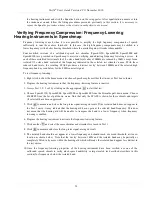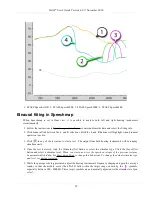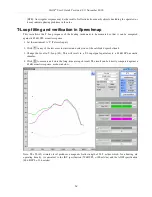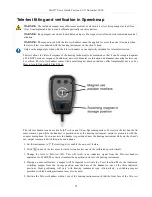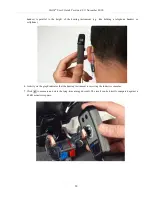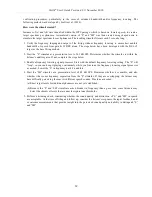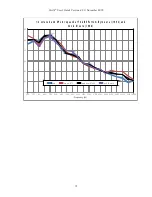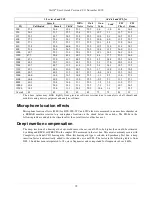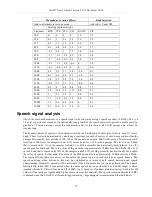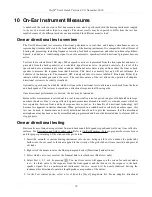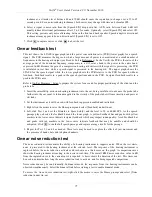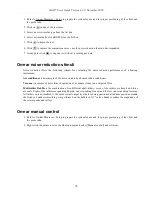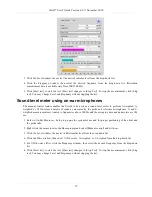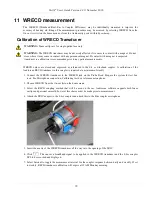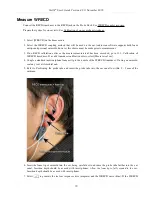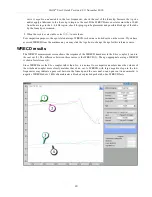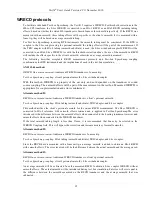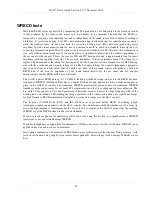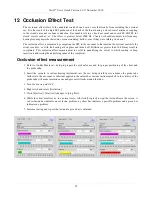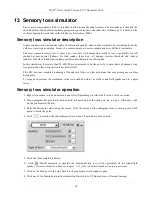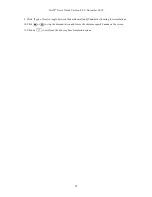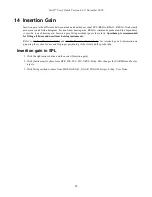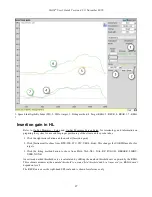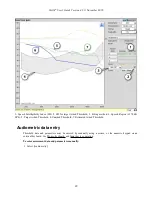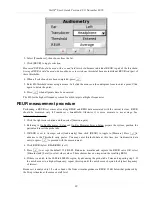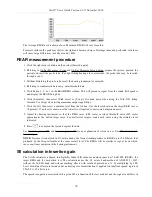
Verifit
®
User's Guide Version 4.8
©
November 2016
instrument, a stimulus level between 60 and 70 dB should cause the separation to change over a 15 to 45
second period. For a noise-reducing instrument, both curves may change with time and stimulus SPL.
6. Select a signal to noise ratio from the [Speech S/N] drop-down list. A S/N ratio between 0 and 6 dB will
usually induce directional performance after 15 to 45 seconds. Optionally, select [Speech SN] and select Off.
This setting presents only noise alternating between the front and back speaker. Speech-adaptive directional
instruments may appear to be non-directional if [Speech S/N] is set to Off.
7. Click
to capture curves or click
to abort the test.
On-ear feedback test
This test shows the LTASS (upper graph) and the power concentration ratio (PCR) (lower graph) for a speech
signal. The PCR measures the degree to which a large amount of power is concentrated at a small number of
frequencies in the hearing aid output (see Freed & Soli in References). In the Verifit, the PCR is the ratio of the
average power of the dominant frequency components in a 1/12 octave band to the power in the entire band,
expressed in dB. Because the gain of a compression hearing aid varies with the signal it is processing, the PCR
is calculated in real time while a speech signal is presented to the hearing aid. The upper graph shows the
LTASS for the speech signal while the lower graph shows the PCR relative to the PCR for speech without
feedback. Feedback results in a peak in the speech spectrum and in the PCR. Incipient feedback results in a
peak in the PCR curve.
Refer to On-Ear Measures - Setup to prepare the system for use and for proper positioning of the client and the
probe tube.
1. Insert the earmold/tip or custom hearing instrument into the ear, being careful not to advance the probe tube
further into the ear canal. A lubricant applied in the vicinity of the probe tube will ease insertion and prevent
slit leaks.
2. Set the instrument as it will be used, with feedback suppression enabled and initialized.
3. Right-click the mouse to raise the Home prompt and select [Feedback] under On-ear.
4. Left-click Test 1 and set the Stimulus to Speech-std(F) and the level to 50 or 60 dB SPL. As the speech
passage plays, observe the feedback bar and the lower graph. A yellow Feedback bar and peaks with yellow
markers in the lower curve indicate incipient feedback which may impact sound quality. A red Feedback bar
and peaks with red markers in the lower curve indicate feedback that may be audible and should be
mitigated. Click
to run the full speech passage and capture average results for the passage.
5. Repeat for Test 2, 3 and 4 as needed. These tests may be used to explore the effects of jaw movement and
the presence of hands, hats and telephone handsets.
On-ear noise reduction test
The noise reduction test measures the ability of a hearing instrument to suppress noise. When the test starts,
noise is presented to the hearing instrument at the selected level. The response of the hearing instrument is
captured before the noise reduction activates and is shown as a thick curve on the graph. A comparison curve
shows the hearing instrument reacting to the noise in real-time. The overall RMS noise reduction value in dB
from the captured curve to the current curve is reported. A timer shows the duration of the test. This timer can
be used to determine how long the noise reduction took to activate, and for doing repeated comparisons.
Noise reduction may be run binaurally. In binaural mode, the responses from two hearing instruments can be
observed simultaneously. Select the binaural link before starting a test to enable binaural mode.
To access the On-ear noise reduction test, right-click the mouse to raise the Home prompt and select [Noise
reduction] under On-ear.
75
Summary of Contents for verifit
Page 1: ...Audioscan Verifit User s Guide 4 8 November 2016...
Page 17: ...Verifit User s Guide Version 4 8 November 2016 EC Declaration of Conformity 17...
Page 92: ...Verifit User s Guide Version 4 8 November 2016 92...
Page 94: ...Verifit User s Guide Version 4 8 November 2016 94...
Page 107: ...Verifit User s Guide Version 4 8 November 2016 Telecoil test results 107...
Page 123: ...Verifit User s Guide Version 4 8 November 2016 123...
Page 148: ...Verifit User s Guide Version 4 8 November 2016 148...
Page 149: ...Verifit User s Guide Version 4 8 November 2016 149...
Page 159: ...Verifit User s Guide Version 4 8 November 2016 159...

